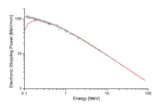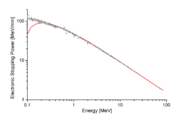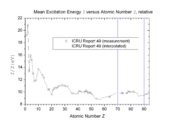
Bethe formula
Encyclopedia
In nuclear physics
and theoretical physics
, charged particles moving through matter interact with the electrons of atoms in the material. The interaction excites or ionizes the atoms. This leads to an energy loss of the traveling particle. The Bethe formula describes the energy loss per distance travelled of swift charged particles (proton
s, alpha particle
s, atomic ion
s, but not electronsFor electrons, the energy loss is slightly different due to their small mass and their indistinguishability, and since they suffer much larger losses by Bremsstrahlung
) traversing matter (or, alternatively, the stopping power
of the material). The non-relativistic
version was found by Hans Bethe
in 1930; the relativistic version (shown below) was found by him in 1932 (Sigmund 2006).
The Bethe formula is sometimes called "Bethe-Bloch formula", but this is misleading (see below).
 (1)
(1)
where
 Here, the electron density of the material can be calculated by
Here, the electron density of the material can be calculated by  , where
, where  is the density of the material,
is the density of the material,  its atomic number
its atomic number
and mass number
, respectively, the Avogadro number and
the Avogadro number and  the Molar mass constant
the Molar mass constant
.
In the figure to the right, the small circles are experimental results obtained from measurements of various authors (taken from http://www.exphys.uni-linz.ac.at/Stopping/); the red curve is Bethe's formula. Evidently, Bethe's theory agrees very well with experiment at high energy. Only below 0.3 MeV, the curve is too low; here, corrections are necessary (see below).
For low energies, i.e., for small velocities of the particle , the Bethe formula reduces to
, the Bethe formula reduces to (2)
(2)
At low energy, the energy loss according to the Bethe formula therefore decreases approximately as with increasing energy. It reaches a minimum for approx.
with increasing energy. It reaches a minimum for approx.  , where
, where  is the mass of the particle (for protons, this would be about at 3000 MeV). For highly relativistic
is the mass of the particle (for protons, this would be about at 3000 MeV). For highly relativistic
cases , the energy loss increases again, logarithmically due to the transversal component of the electric field.
, the energy loss increases again, logarithmically due to the transversal component of the electric field.
 In the Bethe theory, the material is completely described by a single number, the mean excitation potential
In the Bethe theory, the material is completely described by a single number, the mean excitation potential  . Felix Bloch
. Felix Bloch
has shown in 1933 that the mean ionization potential of atoms is approximately given by (3)
(3)
where is the atomic number of the atoms of the material. If this approximation is introduced into formula (1) above, one obtains an expression which is often called Bethe-Bloch formula. But since we have now accurate tables of
is the atomic number of the atoms of the material. If this approximation is introduced into formula (1) above, one obtains an expression which is often called Bethe-Bloch formula. But since we have now accurate tables of  as a function of
as a function of  (see below),the use of such a table will yield better results than the use of formula (3).
(see below),the use of such a table will yield better results than the use of formula (3).
The figure shows normalized values of , taken from a table. The peaks and valleys in this figure lead to corresponding valleys and peaks in the stopping power. These are called "Z2-oscillations" or "Z2-structure" (where Z2 means the atomic number of the target).
, taken from a table. The peaks and valleys in this figure lead to corresponding valleys and peaks in the stopping power. These are called "Z2-oscillations" or "Z2-structure" (where Z2 means the atomic number of the target).
) does not carry any atomic electrons with it. At smaller energies, when the ion carries electrons, this reduces its charge effectively, and the stopping power is thus reduced. But even if the atom is fully ionized, corrections are necessary.
Bethe found his formula using quantum mechanical
perturbation theory
. Hence, his result is proportional to the square of the charge of the particle. The description can be improved by considering corrections which correspond to higher powers of
of the particle. The description can be improved by considering corrections which correspond to higher powers of  . These are: the Barkas-Andersen-effect (proportional to
. These are: the Barkas-Andersen-effect (proportional to  , after Walter H. Barkas
, after Walter H. Barkas
and Hans Henrik Andersen
), and the Bloch
-correction (proportional to ). In addition, one has to take into account that the atomic electrons are not stationary ("shell correction").
). In addition, one has to take into account that the atomic electrons are not stationary ("shell correction").
These corrections have been built into the programs PSTAR and ASTAR, for example, by which one can calculate the stopping power for protons and alpha particles. The corrections are large at low energy and become smaller and smaller as energy is increased.
At very high energies, Fermi
's density correction has to be added also.
calls formula (1) "Bethe's stopping power formula".
On the other hand, in the 2008 Review of Particle Physics the formula was called "Bethe-Bloch equation", even though Bloch's expression (3) did not appear in the formula. As of the most recent edition, this seems to have disappeared with the formula being called only the "Bethe formula".
Nuclear physics
Nuclear physics is the field of physics that studies the building blocks and interactions of atomic nuclei. The most commonly known applications of nuclear physics are nuclear power generation and nuclear weapons technology, but the research has provided application in many fields, including those...
and theoretical physics
Theoretical physics
Theoretical physics is a branch of physics which employs mathematical models and abstractions of physics to rationalize, explain and predict natural phenomena...
, charged particles moving through matter interact with the electrons of atoms in the material. The interaction excites or ionizes the atoms. This leads to an energy loss of the traveling particle. The Bethe formula describes the energy loss per distance travelled of swift charged particles (proton
Proton
The proton is a subatomic particle with the symbol or and a positive electric charge of 1 elementary charge. One or more protons are present in the nucleus of each atom, along with neutrons. The number of protons in each atom is its atomic number....
s, alpha particle
Alpha particle
Alpha particles consist of two protons and two neutrons bound together into a particle identical to a helium nucleus, which is classically produced in the process of alpha decay, but may be produced also in other ways and given the same name...
s, atomic ion
Ion
An ion is an atom or molecule in which the total number of electrons is not equal to the total number of protons, giving it a net positive or negative electrical charge. The name was given by physicist Michael Faraday for the substances that allow a current to pass between electrodes in a...
s, but not electronsFor electrons, the energy loss is slightly different due to their small mass and their indistinguishability, and since they suffer much larger losses by Bremsstrahlung
Bremsstrahlung
Bremsstrahlung is electromagnetic radiation produced by the deceleration of a charged particle when deflected by another charged particle, typically an electron by an atomic nucleus. The moving particle loses kinetic energy, which is converted into a photon because energy is conserved. The term is...
) traversing matter (or, alternatively, the stopping power
Stopping power (particle radiation)
In passing through matter, fast charged particles ionize the atoms or molecules which they encounter. Thus, the fast particles gradually lose energy in many small steps. Stopping power is defined as the average energy loss of the particle per unit path length, measured for example in MeV/cm...
of the material). The non-relativistic
Theory of relativity
The theory of relativity, or simply relativity, encompasses two theories of Albert Einstein: special relativity and general relativity. However, the word relativity is sometimes used in reference to Galilean invariance....
version was found by Hans Bethe
Hans Bethe
Hans Albrecht Bethe was a German-American nuclear physicist, and Nobel laureate in physics for his work on the theory of stellar nucleosynthesis. A versatile theoretical physicist, Bethe also made important contributions to quantum electrodynamics, nuclear physics, solid-state physics and...
in 1930; the relativistic version (shown below) was found by him in 1932 (Sigmund 2006).
The Bethe formula is sometimes called "Bethe-Bloch formula", but this is misleading (see below).
The formula
The relativistic version of the formula reads: (1)
(1)where
 |
 |
 |
velocity of the particle |
 |
energy of the particle |
 |
distance travelled by the particle |
 |
speed of light Speed of light The speed of light in vacuum, usually denoted by c, is a physical constant important in many areas of physics. Its value is 299,792,458 metres per second, a figure that is exact since the length of the metre is defined from this constant and the international standard for time... |
 |
particle charge |
 |
charge of the electron Electron The electron is a subatomic particle with a negative elementary electric charge. It has no known components or substructure; in other words, it is generally thought to be an elementary particle. An electron has a mass that is approximately 1/1836 that of the proton... |
 |
rest mass of the electron |
 |
electron density of the target |
 |
mean excitation potential of the target |
 |
vacuum permittivity |

 , where
, where  is the density of the material,
is the density of the material,  its atomic number
its atomic numberAtomic number
In chemistry and physics, the atomic number is the number of protons found in the nucleus of an atom and therefore identical to the charge number of the nucleus. It is conventionally represented by the symbol Z. The atomic number uniquely identifies a chemical element...
and mass number
Mass number
The mass number , also called atomic mass number or nucleon number, is the total number of protons and neutrons in an atomic nucleus. Because protons and neutrons both are baryons, the mass number A is identical with the baryon number B as of the nucleus as of the whole atom or ion...
, respectively,
 the Avogadro number and
the Avogadro number and  the Molar mass constant
the Molar mass constantMolar mass constant
The molar mass constant, symbol Mu, is a physical constant which relates atomic weight and molar mass. Its value is defined to be 1 g/mol in SI units....
.
In the figure to the right, the small circles are experimental results obtained from measurements of various authors (taken from http://www.exphys.uni-linz.ac.at/Stopping/); the red curve is Bethe's formula. Evidently, Bethe's theory agrees very well with experiment at high energy. Only below 0.3 MeV, the curve is too low; here, corrections are necessary (see below).
For low energies, i.e., for small velocities of the particle
 , the Bethe formula reduces to
, the Bethe formula reduces to (2)
(2)At low energy, the energy loss according to the Bethe formula therefore decreases approximately as
 with increasing energy. It reaches a minimum for approx.
with increasing energy. It reaches a minimum for approx.  , where
, where  is the mass of the particle (for protons, this would be about at 3000 MeV). For highly relativistic
is the mass of the particle (for protons, this would be about at 3000 MeV). For highly relativisticTheory of relativity
The theory of relativity, or simply relativity, encompasses two theories of Albert Einstein: special relativity and general relativity. However, the word relativity is sometimes used in reference to Galilean invariance....
cases
 , the energy loss increases again, logarithmically due to the transversal component of the electric field.
, the energy loss increases again, logarithmically due to the transversal component of the electric field.The mean excitation potential

 . Felix Bloch
. Felix BlochFelix Bloch
Felix Bloch was a Swiss physicist, working mainly in the U.S.-Life and work:Bloch was born in Zürich, Switzerland to Jewish parents Gustav and Agnes Bloch. He was educated there and at the Eidgenössische Technische Hochschule, also in Zürich. Initially studying engineering he soon changed to physics...
has shown in 1933 that the mean ionization potential of atoms is approximately given by
 (3)
(3)where
 is the atomic number of the atoms of the material. If this approximation is introduced into formula (1) above, one obtains an expression which is often called Bethe-Bloch formula. But since we have now accurate tables of
is the atomic number of the atoms of the material. If this approximation is introduced into formula (1) above, one obtains an expression which is often called Bethe-Bloch formula. But since we have now accurate tables of  as a function of
as a function of  (see below),the use of such a table will yield better results than the use of formula (3).
(see below),the use of such a table will yield better results than the use of formula (3).The figure shows normalized values of
 , taken from a table. The peaks and valleys in this figure lead to corresponding valleys and peaks in the stopping power. These are called "Z2-oscillations" or "Z2-structure" (where Z2 means the atomic number of the target).
, taken from a table. The peaks and valleys in this figure lead to corresponding valleys and peaks in the stopping power. These are called "Z2-oscillations" or "Z2-structure" (where Z2 means the atomic number of the target).Corrections to the Bethe formula
The Bethe formula is only valid for energies high enough so that the charged atomic particle (the ionIon
An ion is an atom or molecule in which the total number of electrons is not equal to the total number of protons, giving it a net positive or negative electrical charge. The name was given by physicist Michael Faraday for the substances that allow a current to pass between electrodes in a...
) does not carry any atomic electrons with it. At smaller energies, when the ion carries electrons, this reduces its charge effectively, and the stopping power is thus reduced. But even if the atom is fully ionized, corrections are necessary.
Bethe found his formula using quantum mechanical
Quantum mechanics
Quantum mechanics, also known as quantum physics or quantum theory, is a branch of physics providing a mathematical description of much of the dual particle-like and wave-like behavior and interactions of energy and matter. It departs from classical mechanics primarily at the atomic and subatomic...
perturbation theory
Perturbation theory
Perturbation theory comprises mathematical methods that are used to find an approximate solution to a problem which cannot be solved exactly, by starting from the exact solution of a related problem...
. Hence, his result is proportional to the square of the charge
 of the particle. The description can be improved by considering corrections which correspond to higher powers of
of the particle. The description can be improved by considering corrections which correspond to higher powers of  . These are: the Barkas-Andersen-effect (proportional to
. These are: the Barkas-Andersen-effect (proportional to  , after Walter H. Barkas
, after Walter H. BarkasWalter H. Barkas
Walter H. Barkas was Professor of Physics at the University of California, Riverside from 1965 on...
and Hans Henrik Andersen
Hans Henrik Andersen
Hans Henrik Andersen is Professor at the Niels Bohr Institute of the University of Copenhagen...
), and the Bloch
Felix Bloch
Felix Bloch was a Swiss physicist, working mainly in the U.S.-Life and work:Bloch was born in Zürich, Switzerland to Jewish parents Gustav and Agnes Bloch. He was educated there and at the Eidgenössische Technische Hochschule, also in Zürich. Initially studying engineering he soon changed to physics...
-correction (proportional to
 ). In addition, one has to take into account that the atomic electrons are not stationary ("shell correction").
). In addition, one has to take into account that the atomic electrons are not stationary ("shell correction").These corrections have been built into the programs PSTAR and ASTAR, for example, by which one can calculate the stopping power for protons and alpha particles. The corrections are large at low energy and become smaller and smaller as energy is increased.
At very high energies, Fermi
Fermi
Fermi may refer to*Enrico Fermi*Laura Fermi, Enrico Fermi's wife*Enrico Fermi Award*Fermi Paradox , an album by Tub RingTechnology:*Fermi, the codename for a CUDA architecture graphics card developed by Nvidia*Fermi Gamma-ray Space Telescope...
's density correction has to be added also.
The problem of nomenclature
In describing programs PSTAR and ASTAR, the National Institute of Standards and TechnologyNational Institute of Standards and Technology
The National Institute of Standards and Technology , known between 1901 and 1988 as the National Bureau of Standards , is a measurement standards laboratory, otherwise known as a National Metrological Institute , which is a non-regulatory agency of the United States Department of Commerce...
calls formula (1) "Bethe's stopping power formula".
On the other hand, in the 2008 Review of Particle Physics the formula was called "Bethe-Bloch equation", even though Bloch's expression (3) did not appear in the formula. As of the most recent edition, this seems to have disappeared with the formula being called only the "Bethe formula".
External links
- The Energy Loss of charged particles passing through matter
- Original Publication: Zur Theorie des Durchgangs schneller Korpuskularstrahlen durch Materie in "Annalen der Physik", Vol. 397 (1930) 325 -400
- Passage of charged particles through matter, with a graph
- Stopping power for protons and alpha particles
- Stopping Power graphs and data

